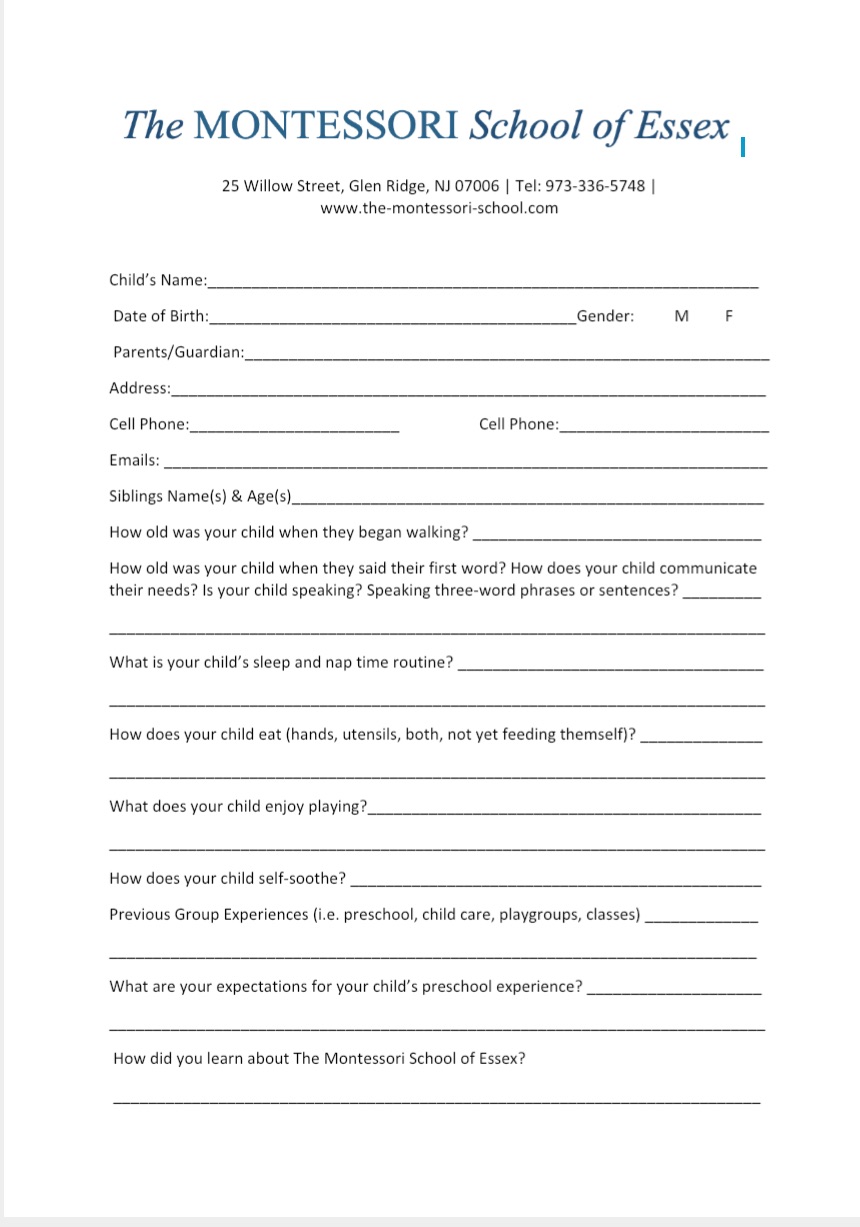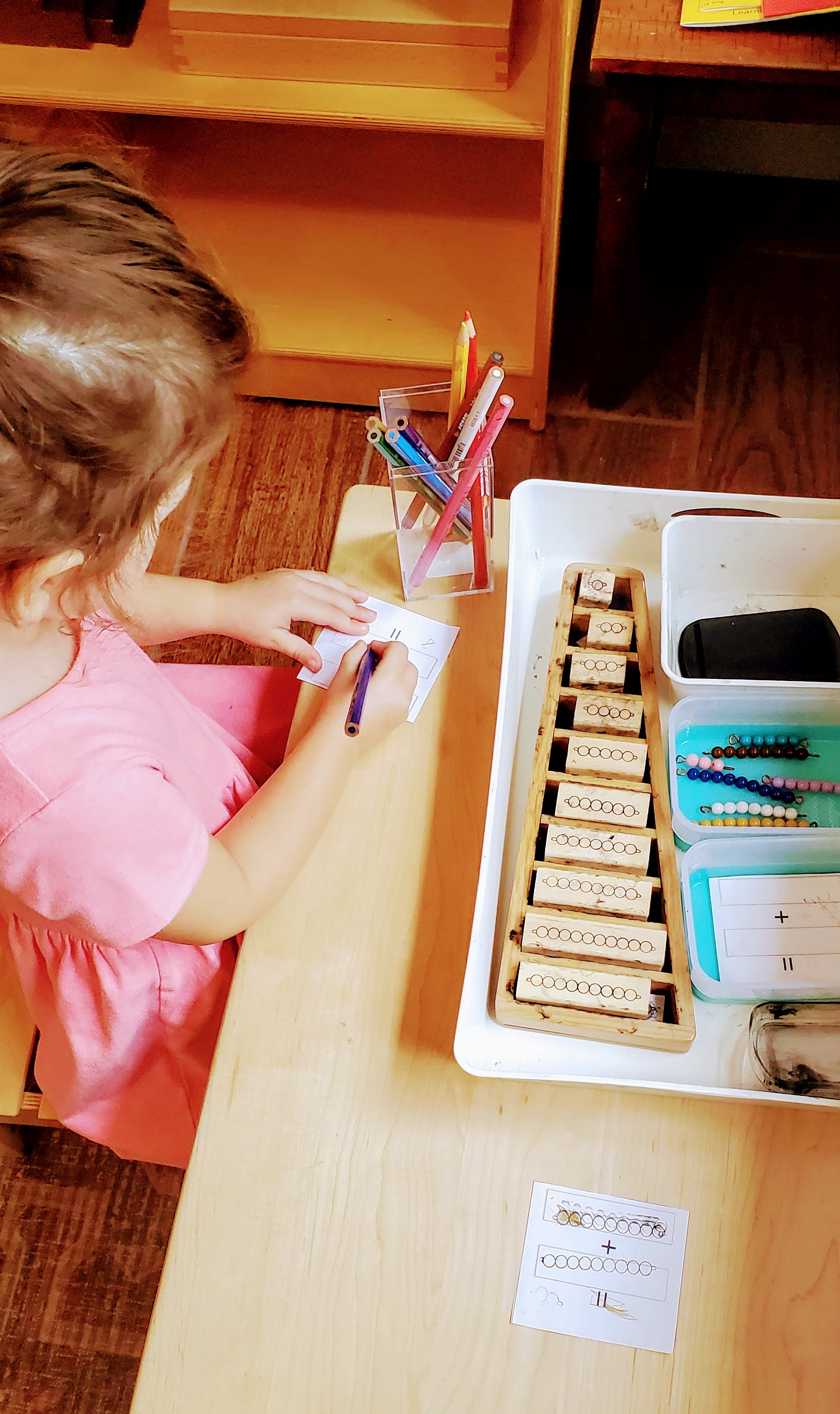
Montessori in the Home
Here are a few tips that can be integrated into your daily schedule. Always offer freedom of movement, this is how we learn. Show your child how to un/dress, offer two clothing choices, prepare meals together, model and encourage how to eat with utensils, drink from a small glass, sleep in a floor bed, and offer words for their feelings/behavior. Protect their concentration, don’t interrupt them, and allow them to complete their project. A little struggle is good, it allows for critical thinking and problem solving. Only intervene unless you observe the three ‘Ds” (Destructive, Disrespectful or Dangerous). Create a designated spot for their toys, don’t over stimulate them with too much. Periodically rotate their toys. Collaborate putting things away, help each other, and eventually your child will clean up independently (as best they can for their age). Routine, consistency, and modeling appropriate behavior and words enables young children to feel successful in social situations and a sense of orientation in different environments. Toilet learning is also very important. In the beginning, it’s not about a child producing but becoming used to this new way of life. Toileting is done in the bathroom and is no longer passive- your child helps because it is their work (not yours). Diapers are changed standing and your child sits on the potty while you grab a clean diaper or underwear. For more information on toilet learning, please find toilet learning blog.
Three Areas to Consider:
- Sleeping– floor bed, quiet, low light, peaceful
- Personal Care– In the beginning a changing table with everything you need is in arms reach. When your child is walking steady, personal care moves to the bathroom or an area of the home where the family spends most of their time. Establish a routine and consistency using a small potty, a receptacle for soiled clothes, clean clothes, a stool, sink, and soap. Now there a collection of items available in your child’s reach as well as your reach. Toileting is about establishing a consistent routine that works for your child and family’s schedule. This is not about the child producing, in the beginning it is about your child becoming used to this new way of personal care.
- Movement– gross motor (climbing, pushing, pulling, lifting, throwing, etc.) and fine motor activities (open/close, puzzles, clay, food prep, etc.) on low shelves, a toddler table and chair.
- Meals– In the beginning, this is in a parent’s arms. When your child is sitting up (5 months) place your child in a weaning chair and table, here they begin a new a relationship with you by sitting across from you, your child begins to test new foods, and practice their eye-hand coordination with a spoon. When your child is walking steady, some meals might be at their toddler table and chair and other meals might be in a chair that enables your child to sit at the kitchen or dining room table. It’s important not to lock your child down with straps. Teach them how to independently sit, eat, and enjoy each other’s company.
















Worms
Suggested Activities:
Let’s learn all about worms and their important work!

DIY Wormery Project: Make Your Own Wormery!
Clay, Playdough, Biscuits
Suggested Activities:
Children’s hands need work. Their hands love to open/close, squeeze, pinch, pull, push, etc. Let’s satisfy this need with purposeful work they enjoy. Clay, playdough, and biscuit work strengthen their hands, aid in the development of their senses, language, and kinesthetic learning. In the beginning, children make spheres and coils, pinch apart into little pieces, and taste (mouthing). Later, it’s about using rolling pins, cookie cutters, creating sculptures, making pots and bowls, and cooking.
Clay:
Sculptor’s clay is best. Use a firm clay that becomes soft when it is warmed up with your hands. This is a great workout for children’s hands and will become easier as their hands become stronger.
Playdough Recipe: Easy to manipulate and very good for children still discovering with their mouth.
- 1/2 cup salt
- 1 cup water
- 1 tablespoon of vegetable oil
- 1 tablespoons cream of tartar
- 1 cup of flour
- Food coloring
- Mix water and food coloring
- Mix salt, water/color mixture, oil, and cream of tartar in a pan and heat until warm
- Remove pan from heat and add flour
- Knead the dough until smooth. Be careful, it might be hot
- When play dough is ready, cut down into golf ball sizes and wrap individually with plastic wrap or air tight container or freezer bag. Freeze until ready to use
Biscuit Recipe: The best work for children (walking steady-onward), you see the biggest smile because it is the most rewarding!
- 1 cup flour
- 1/2 teaspoon baking powder
- 1/2 teaspoon salt
- 3 tablespoons butter
- 1/4 cup milk or soy
- Mixing bowl, cutting board, 2 spoons, rolling pin, biscuit cutter, small baking pan (9″x9″)
- Preheat oven 400 degrees, bake biscuits for 10 -/+ minutes
- Mix dry ingredients: flour, baking powder, and salt
- Add butter to dry ingredients and pinch into tiny pieces
- Add wet ingredient: milk or soy and mix with a spoon
- When the it begins to look ‘doughy’ transfer to a cutting board
- Knead and roll with a rolling pin
- Flatten the dough (like a pizza) and press with a cookie cutter
- Place cut dough on baking pan
- The child might repeat the kneading, rolling, and cutting
- When the child is done, place biscuits in the oven for 10 minutes or until golden
Shadows
Can you find your shadow? Let’s cast shadows inside and outside!
- Body- hand puppets, wave, move around
- Toys, like stuffed animals- cast shadows against paper or ground
- Nature- large branches, flowers, birds flying by
- Can you make your shadow small and big?
- Where is your shadow? Front, behind or next to?
- What makes light? Sun, moon, candles, light bulbs
Extension: chalk or crayon outline of shadow. Fill the outline with color, patterns, tape areas to make ‘stain glass’, simplify the body outline like the artist Kieth Haring- have fun, goofier the better







